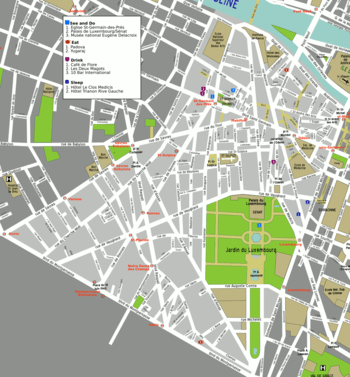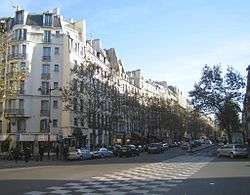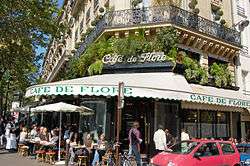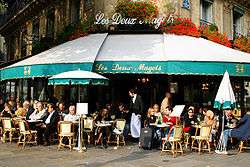6th arrondissement of Paris
| 6th arrondissement of Paris | |
|---|---|
| French municipal arrondissement | |
|
The "Deux Magots" cafe | |
 Paris and its closest suburbs | |
| Country | France |
| Region | Île-de-France |
| Department | Paris |
| Commune | Paris |
| Government | |
| • Mayor | Jean-Pierre Lecoq |
| Area | |
| • Total | 2.15 km2 (0.83 sq mi) |
| Population (8 March 1999 census)[p] | |
| • Total | 44,919 |
| • Estimate (2005) | 45,200 |
| • Density | 21,000/km2 (54,000/sq mi) |
| ^[p] Population sans doubles comptes: single count of residents of multiple communes (e.g. students and military personnel). | |
 20 arrondissements of Paris | |||||||||||||||||||||||||||||||||||||
|---|---|---|---|---|---|---|---|---|---|---|---|---|---|---|---|---|---|---|---|---|---|---|---|---|---|---|---|---|---|---|---|---|---|---|---|---|---|
| |||||||||||||||||||||||||||||||||||||
The 6th arrondissement of Paris is one of the 20 arrondissements (administrative districts) of Paris, France. It includes world famous educational institutions such as the École des Beaux-Arts de Paris and the Académie française, the seat of the French Senate as well as a concentration of some of Paris's most famous monuments such as Saint-Germain Abbey and square, St. Sulpice Church and square, the Pont des Arts and the Jardin du Luxembourg.
Situated on the left bank of the River Seine, this central arrondissement which includes the historic districts of Saint-Germain-des-Prés (surrounding the Abbey founded in the 6th century) and Luxembourg (surrounding the Palace and its Gardens) has played a major role throughout Paris history and is well known for its café culture and the revolutionary intellectualism (see: Existentialism, Jean-Paul Sartre, Simone de Beauvoir) and literature (see: Paul Éluard, Boris Vian, Albert Camus, Françoise Sagan) it has hosted.
With its world famous cityscape, deeply rooted intellectual tradition, prestigious history, beautiful architecture and central location, the arrondissement has long been home to French intelligentsia. It is a major locale for art galleries and one of the most fashionable districts of Paris as well as Paris' most expensive area. The arrondissement is one of France's richest district in terms of average income, it is part of Paris Ouest alongside the 7th, 8th, 16th arrondissements and Neuilly, but has a much more bohemian and intellectual reputation than the others.
History
The current 6th arrondissement, dominated by the Abbey of Saint-Germain-des-Prés—founded in the 6th century—was the heart of the Catholic Church power in Paris for centuries, hosting many religious institutions.
In 1612, Queen Marie de Médicis bought an estate in the district and commissioned architect Salomon de Brosse to transform it into the outstanding Luxembourg Palace surrounded by extensive royal gardens. The new Palace turned the neighborhood into a fashionable district for French nobility.
Since the 1950s, the arrondissement, with its many higher education institutions, world famous cafés (Café de Flore, Les Deux Magots, La Palette etc.) and publishing houses (Gallimard, Julliard, Grasset etc.) has been the home of much of the major post-war intellectual and literary movements and some of most influential in history such as surrealism, existentialism and modern feminism.
Geography


The land area of the arrondissement is 2.154 km² (0.832 sq. miles, or 532 acres).
Cityscape
-

Palace Hôtel Lutetia at night
-

-

Le Café de Flore in Saint-Germain-des-Prés
Places of interest
- Académie française
- French Senate (Luxembourg Palace)
- Jardin du Luxembourg
- Medici Fountain
- Pont des Arts
- Pont Neuf
- Pont Saint-Michel
- Saint-Germain-des-Prés Quarter and former abbey
- Latin Quarter (partial)
- Saint-Sulpice church
- Odéon-Théâtre de l'Europe
- Théâtre du Vieux-Colombier
- Café de Flore
- Les Deux Magots
- Polidor
- Hôtel de Chimay
- Hôtel Lutetia
- Café Procope
Museums
- Fondation Jean Dubuffet
- Maison d'Auguste Comte
- Monnaie de Paris
- Musée d'Anatomie Delmas-Orfila-Rouvière
- Musée Edouard Branly
- Musée Hébert
- Musée – Librairie du Compagnonnage
- Musée de Minéralogie
- Musée Zadkine
Colleges and universities
- École nationale des ponts et chaussées
- École nationale supérieure des mines de Paris
- École nationale supérieure des Beaux-Arts
- École des hautes études en sciences sociales
- Pantheon-Assas University (main campus)
- Lycée Montaigne
- Lycée Saint-Louis
- Lycée Stanislas
- Lycée Fénelon
Former places
Main streets and squares
- Place du 18-Juin-1940
- Rue de l'Abbaye
- Rue de l'Ancienne Comédie
- Rue André-Mazet
- Rue d'Assas
- Rue Auguste Comte
- Rue de Beaux Arts
- Rue Bonaparte
- named after Napoleon 1
- Rue Bréa
- Rue de Buci
- named after Simon de Buci, President of the Parlement of Paris, who had purchased the Gate Saint-Germain (now demolished) in 1350
- Rue des Canettes
- Rue Cassette
- Rue du Cherche-Midi
- Rue Christine
- Rue de Condé
- named after the former Hôtel de Condé, of which forecourt faced the street
- Quai de Conti
- Rue Danton
- Passage Dauphine
- Rue Dauphine
- named after the Dauphin, son of Henry IV of France
- Rue du Dragon
- Rue Duguay-Trouin
- Rue Dupin
- Rue de l'École de Médecine
- Rue de Fleurus
- Rue du Four
- Place de Furstemberg
- Rue de Furstemberg
- Rue Garancière
- Quai des Grands-Augustins
- Rue des Grands Augustins
- Rue Grégoire de Tours
- Rue Guisarde
- Rue Guynemer
- Rue Hautefeuille
- Place Henri Mondor
- Rue Jacques Callot
- Rue du Jardinet
- Rue Jacob
- Rue Lobineau
- Rue Mabillon
- Rue Madame
- Quai Malaquais
- Rue Mayet
- Rue Mazarine
- Rue de Médicis
- Rue de Mézières
- Rue Mignon
- Rue Monsieur-le-Prince
- Boulevard du Montparnasse
- Rue de Nesle
- Rue de Nevers
- Rue Notre-Dame des Champs
- Carrefour de l'Odéon
- Rue de l'Odéon
- Rue Palatine
- Rue Pierre Sarrazin
- Rue des Poitevins
- Rue du Pont de Lodi
- named after Bonaparte's victory on May 10, 1796, at the Battle of Lodi
- Rue Princesse
- Rue des Quatre Vents
- Place du Québec
- Boulevard Raspail
- named after François Vincent Raspail (1794–1878) French chemist and politician
- Rue de Rennes
- Rue Saint-André-des-Arts
- Rue Saint-Benoît
- Boulevard Saint-Germain (partial)
- Rue Saint-Jean-Baptiste de la Salle
- Boulevard Saint-Michel (partial)
- Place Saint-Michel (partial)
- Place Saint-Sulpice
- Rue Saint-Sulpice
- Rue des Saints Pères
- Rue de Savoie
- Rue de Seine
- Rue de Sèvres
- Rue Stanislas
- named after the nearby collège Stanislas, founded under Louis XVIII of France, and named after one of his first names
- Rue de Tournon
- Rue de Vaugirard (partial)
- Rue Vavin
- named after the 19th-century politician Alexis Vavin
- Rue Visconti
Demography
The arrondissement attained its peak population in 1911 when the population density reached nearly 50,000 inhabitants per km². In 1999, the population was 44,919 inhabitants while the arrondissement provided 43,691 jobs.
Economy
Toei Animation Europe has its head office in the arrondissement. The company, which opened in 2004, serves France, Germany, Italy, Spain, and the United Kingdom.[1]
Real estates
The 6th and 7th arrondissements are the most expensive districts of Paris, the most expensive parts of the 6th arrondissement being Saint-Germain-des-Prés quarter, the River side districts and the areas nearby the Luxembourg Garden.
Historical population
| Year (of French censuses) |
Population | Density (inh. per km²) |
|---|---|---|
| 1872 | 90,288 | 41,994 |
| 1911 (peak of population) | 102,993 | 47,815 |
| 1954 | 88,200 | 41,023 |
| 1962 | 80,262 | 37,262 |
| 1968 | 70,891 | 32,911 |
| 1975 | 56,331 | 26,152 |
| 1982 | 48,905 | 22,704 |
| 1990 | 47,891 | 22,234 |
| 1999 | 44,919 | 20,854 |
| 2009 | 43,143 | 20,067 |
Immigration
| |||||||||||||||||||
References
- ↑ "AFFILIATED COMPANIES." Toei Animation. Retrieved on November 17, 2011. "37 rue du Four 75006 Paris France"
External links
| Wikimedia Commons has media related to Paris 6e arrondissement. |
-
 6th arrondissement travel guide from Wikivoyage
6th arrondissement travel guide from Wikivoyage
Coordinates: 48°51′1.91″N 2°19′56.04″E / 48.8505306°N 2.3322333°E
